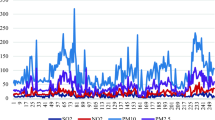Abstract
The real-time monitoring of the air pollution with multiple sources is of great significance for pollution control and environmental protection. In this paper, we presented a study of terahertz time-domain spectroscopy (THz-TDS) as a direct tool for monitoring the component and content of PM2.5 in atmosphere. Due to the THz absorption, the intensities of the peaks in THz-TDS decreased with the augment of PM2.5 and were proportional to the PM2.5 content. The ratio of absorbance A to PM2.5 reflected a basically unchanged tendency, indicating the little change of principal elements under the pollution degree. In the high-pollution condition, a lot of SO2 from vehicle and factory was emitted into air. The elements, such as S and O from anions, had a stronger absorption effect in THz range. Based on the absorbance spectra, the absorption tendencies with PM2.5 over the whole range were validated by principal component analysis and the quantitative model with a high correlation was built by using back propagation artificial neural network. BPANN model improved the precision of linear fitting between peak intensities and PM2.5. The research demonstrates that THz-TDS is a promising tool for fast, direct, and reliable monitoring in environmental applications.





Similar content being viewed by others
References
Y. Yuan, S. Liu, R. Castro, and X. Pan, Environ. Sci. Technol. 46, 3627–3628 (2012).
K. Austen, Nature 517, 136–138 (2015).
D. Y. H. Pui, S. C. Chen, and Z. Zuo, Particuology 13, 1–26 (2014).
C. Loftus, M. Yost, P. Sampson, G. Arias, E. Torres, V. B. Vasquez, P. Bhatti, and C. Karr, Environ. Res. 136, 505–512 (2015).
N. Chu, J. B. Kadane, and C. I. Davidso, Environ. Sci. Technol. 43, 2407–2411 (2009).
C. Brokamp, M. B. Rao, Z. Fan, and P. H. Ryan, Atmos. Environ. 101, 226–234 (2015).
J. Wagner, K. Naik-patel, S. Wall, and M. Harnly, Atmos. Environ. 54, 260–271 (2012).
H. L. Zhan, S. X. Wu, R. M. Bao., L. N. Ge, and Zhao K, Fuel 143, 189–193 (2015).
H. Pűhringer, Z. Nejim, M. Pfleger, S. Katletz, J. Infrared Milli. Terahz. Waves 37, 123–127 (2016).
X. Feng, S. X. Shi, K. Zhao, W. Wang, H. L. Zhan, C. Jiang, L. Z. Xiao, and S. H. Chen, Opt. Express 23, 1693–1699 (2015).
H. Zhao, K. Zhao, R. M. Bao, J. Infrared Milli. Terahz. Waves 33, 522–528 (2012)
L. N. Ge, H. L. Zhan, W. X. Leng, K. Zhao, and L. Z. Xiao, Energy Fuels 29, 1622–1627 (2015).
H. L. Zhan, S. X. Wu, R. M. Bao, K. Zhao, L. Z. Xiao, L. N. Ge, and H. J. Shi, RSC Adv. 5, 14389–14392 (2015).
Q. Li, K. Zhao, L. W. Zhang, C. Liang, Z. W. Zhang, C. L. Zhang, and D. H. Han, Sci. China-Phys.Mech. Astron. 57, 2354–2356 (2014).
P. U. Jepsen, D. G. Cooke, and M. Koch. Laser Photonics Rev. 5, 124–166 (2011).
W. X. Leng, H. L. Zhan, L. N. Ge, W. Wang, Y. Ma, K. Zhao, S. Y. Li, and L. Z. Xiao, Fuel 159, 84–88 (2015).
H. L. Zhan, Q. Li, K. Zhao, L. W. Zhang, Z. W. Zhang, C. L. Zhang, and L. Z. Xiao, IEEE T. THz Sci. Techn. 5, 1–7 (2015).
H. L. Zhan, S. N. Sun, K. Zhao, W. X. Leng, R. M. Bao, and L. Z. Xiao. Sci. China Tech. Sci. 58, 2104–2109 (2015).
M. Kaushik, B. W. H. Ng, B. M. Fischer and D. Abbott. Appl. Phys. Lett. 100, 011107 (2012).
S. Han, J. S. Youn, and Y. W. Jung, Atmos. Environ. 45, 3343–3351 (2011).
A. D. Burnett, W. Fan, P. C. Upadhya, J. E. Cunningham, M. D. Hargreaves, T. Munshi, H. G. Edwards, E. H. Linfield, and A. G. Davies. Analyst 134, 1658–1668 (2009).
S. Jiang, Z. Ren, K. Xue, and C. Li, J. Mater. Process Tech. 196, 190–196 (2008).
Acknowledgments
This work was supported by the National Key Basic Research Program of China (Grant No. 2014CB744302), the Specially Funded Program on National Key Scientific Instruments and Equipment Development (Grant No. 2012YQ140005), and the National Nature Science Foundation of China (Grant Nos. 11574401 and 61405259).
Author information
Authors and Affiliations
Corresponding author
Rights and permissions
About this article
Cite this article
Zhan, H., Zhao, K., Bao, R. et al. Monitoring PM2.5 in the Atmosphere by Using Terahertz Time-Domain Spectroscopy. J Infrared Milli Terahz Waves 37, 929–938 (2016). https://doi.org/10.1007/s10762-016-0283-8
Received:
Accepted:
Published:
Issue Date:
DOI: https://doi.org/10.1007/s10762-016-0283-8



